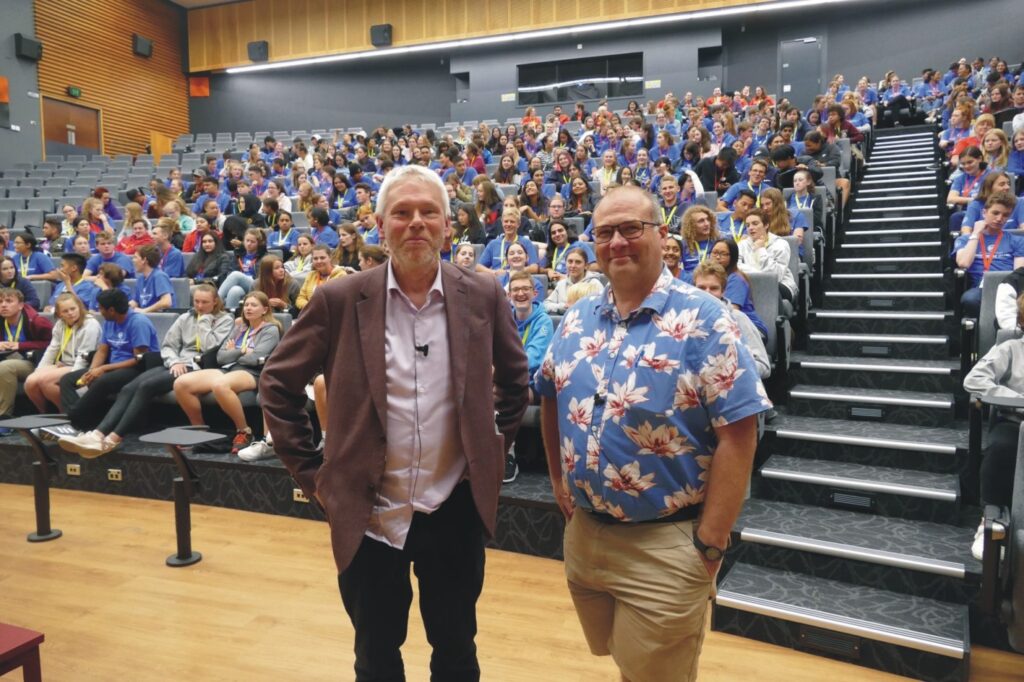Expedition 13 returns from Antarctica
Early this week Otago Space Physics Antarctic Expedition 13 returned to New Zealand. Expedition 13 was made up of Craig Rodger, James Brundell, and PhD student Daniel Mac Manus. The travel was not entirely smooth; weather related issues meant the flight South was delayed by 3 days, arriving on Friday 26 November 2021. The team had to work hard to get all the science goals done before the return, which happened as scheduled. Expedition 13 landed in Christchurch at 1230am on Tuesday 7 December 2021, and returned to Dunedin mid- that afternoon. There was even time for Craig Rodger to give a science talk on Space Weather in the Scott Base bar, and for Daniel and James to view a solar eclipse from the top of Castle Rock. There is more information on the webpage describing Expedition 13’s goals, and the predeparture isolation [9 December 2021].
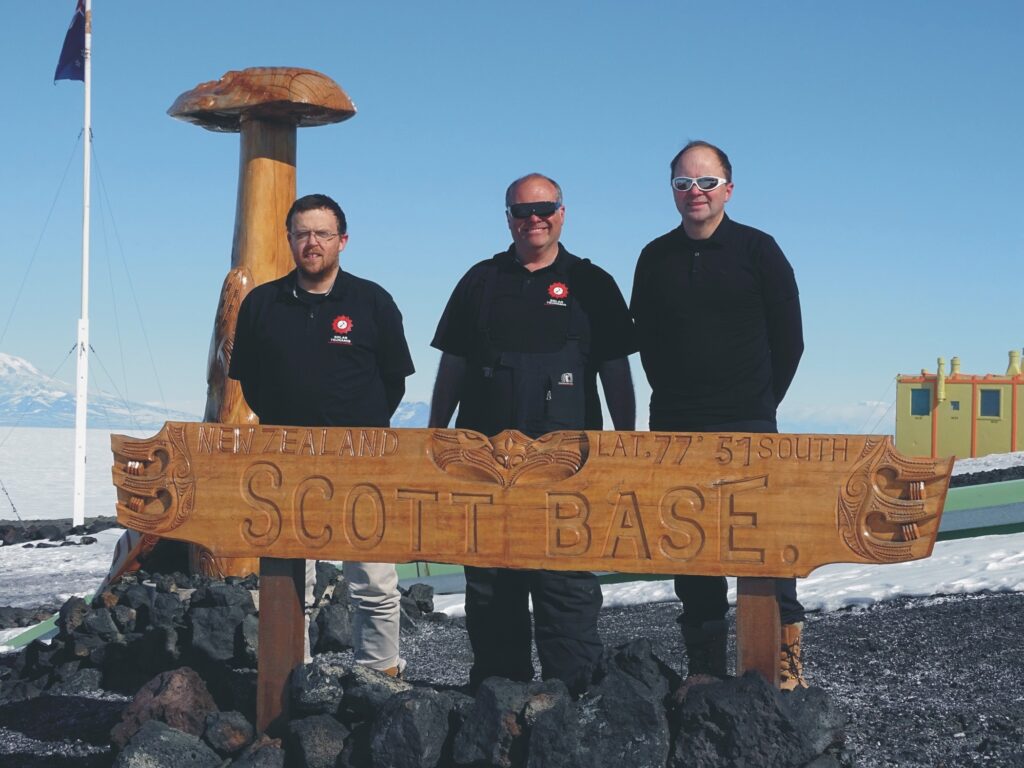
Daniel, Craig, and James, on the ice.
Isolation before travel to Antarctica for Expedition 13
Most years the Otago Space Physics research group sends a team to Scott Base in Antarctica to undertake maintenance on our VLF antenna. The trip in November 2020 could not take place due to the impact of COVID-related restrictions. But with much thought and planning, we decided to go ahead wiith Space Physics Antarctic Expedition 13 in 2021, working with Antarctica New Zealand. This started with the three-man team entering isolation at the Southern Cross Lodge in Methven in early-mid November. The plan is to spend 2 weeks in the facility, after which we can fly south to Antarctica. Expedition 13 was made up of Craig Rodger, James Brundell, and PhD student Daniel Mac Manus. There is more information on the webpage describing Expedition 13’s goals, and the predeparture isolation [10 November 2021].
Variometer installed near Invercargill
In early October a team of us travelled south to Invercargill to install a magnetic field variometer. Craig, Anna Tarr, Aaron Hendry, and James Brundell went down together to work on the install; we took a bigger team to make sure we got the first one right. The variometer is being hosted the Awarua Satellite Ground Station facility, owned and operated by Space Operations New Zealand. We installed it to support the MBIE Solar Tsunamis research project, and you can read more about the installation at that website [11 October 2021].
Solar Tsunamis Website Launched
After much work behind the scenes by Anna and James, we have finally launched the website for our MBIE Endeavour funded Solar Tsunamis research programme. The website has actually existed much longer than that, but we needed material, images and wanted to wait for the logo too. And of course bug fixes. Well done Anna! [17 September 2021].
Solar Tsunamis Logo Launched on the Anniversary of the Carrington Event
The 2nd of September 2021 marked the 162nd anniversary of the 1859 Carrington Event causing intense aurora across the skies of New Zealand. To mark the anniversary our Otago Museum partners in the MBIE Endeavour funded Solar Tsunamis research programme launched our new programme logo. Otago Museum ran a competition across all the kura in New Zealand. The winning creation was made by Maikel Terekia, a 13-year-old from Te Kura Kaupapa Māori o Horouta Wānanga in Gisborne. Kia Ora Maikel! [2 September 2021].
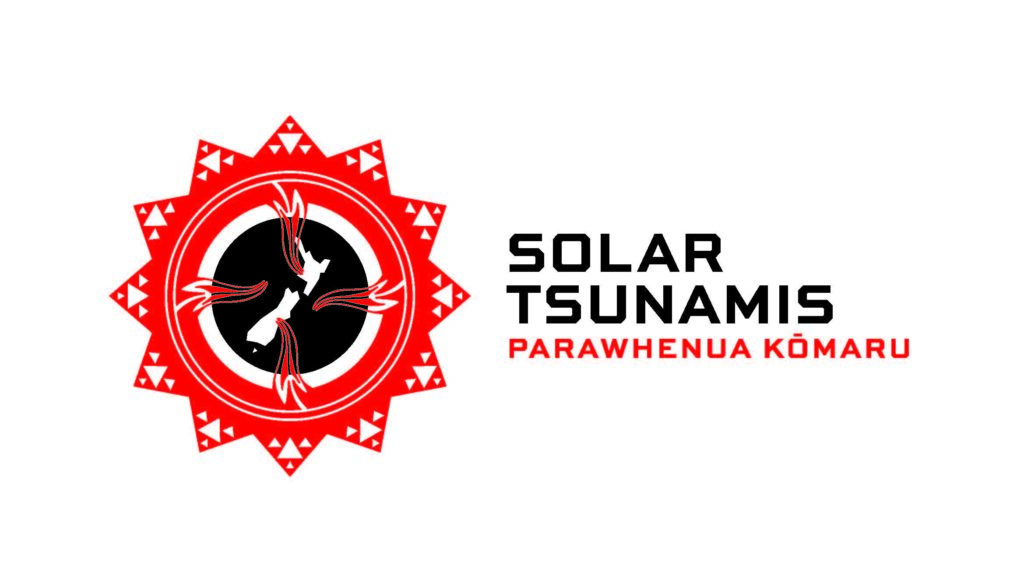
Craig Elected as Vice-Chair of URSI Commission H
In August-September 2021 the 33rd General Assembly of the International Union of Radio Science (URSI) was held as a hybrid meeting, online and in Rome (Italy). The meeting was original to be in-person in Rome in August 2020, but was delayed a year due to COVID-19. Craig attended at the New Zealand URSI delegate, gave two oral presentations, chaired two sessions, and was also elected the vice-chair of Commission H. The voting is undertaken by the official national representatives of Commission H to URSI, which spans 44 countries. Craig Rodger was elected as Vice Chair of the “Waves in Plasma” commission of the URSI scientific union, one of the 10 sections in URSI’s structure. URSI was one of founding scientific unions which now make up the International Council for Science, and its mission is to all aspects of electromagnetic fields and waves [31 August 2021].
Daniel and Craig Travel to Wellington
Last week PhD student Daniel MacManus and Craig Rodger travelled to Wellington. The main reason for the travel was to attend the 2021 New Zealand Institute of Physics conference (NZIP & PHYSIKOS Conference 12-14 July 2021). Both Daniel and Craig gave oral presentations, Craig more broadly on Space Weather, Daniel specifically on New Zealand Geomagnetically Induced Current (GIC) modelling. After the meeting Craig and Daniel visited Transpower NZ Ltd to talk about our research, and up the hill to Victoria University. On Friday Craig met with multiple staff members of MBIE to talk about Space Weather. It felt like a valuable, if tiring, trip north [12-16 July 2021].
Craig Featured in SpaceBase Podcast
On Monday this week Craig’s was interview by Emeline Paat-Dahlstrom, CEO of SpaceBase. They are a New Zealand social enterprise focused on encouraging the wider New Zealand space eco-system. The interview focused on Craig’s career, research, and thoughts on encouraging young people into space-based careers. This produced a ~45min podcast entitled Predicting Solar Tsunamis to Tracking Red Sprites: An Interview with Craig Rodger which was published online on 26 May 2021. This is episode 27 of a series of podcasts talking to a wide range people in the New Zealand space system.
Solar Tsunamis MBIE Research Programme featured in University of Otago Magazine
The latest version of the University of Otago Magazine, aimed at Otago alumni, contains a four-page artiicle on our “new” MBIE-funded research programme. The programmes full name is the Solar Tsunamis: Space-Weather Prediction and Risk Mitigation for New Zealand’s Energy Infrastructure research programme, funded by the Ministry of Business, Innovation & Employment through the Endeavour Fund (1 October 2020-30 September 2025). This programme will investigates how solar explosions impact New Zealand energy networks, with our main focus on the electrical power network and natural gas pipelines. Our energy industry partners have identified the detailed questions that need to be answered. Our research will address these questions to allow mitigation of extreme storm space weather hazards. The Alumni magazine article provides an entry-level description of what we hope to achieve in an article called What happens when the Sun goes Bang? [27 April 2021].
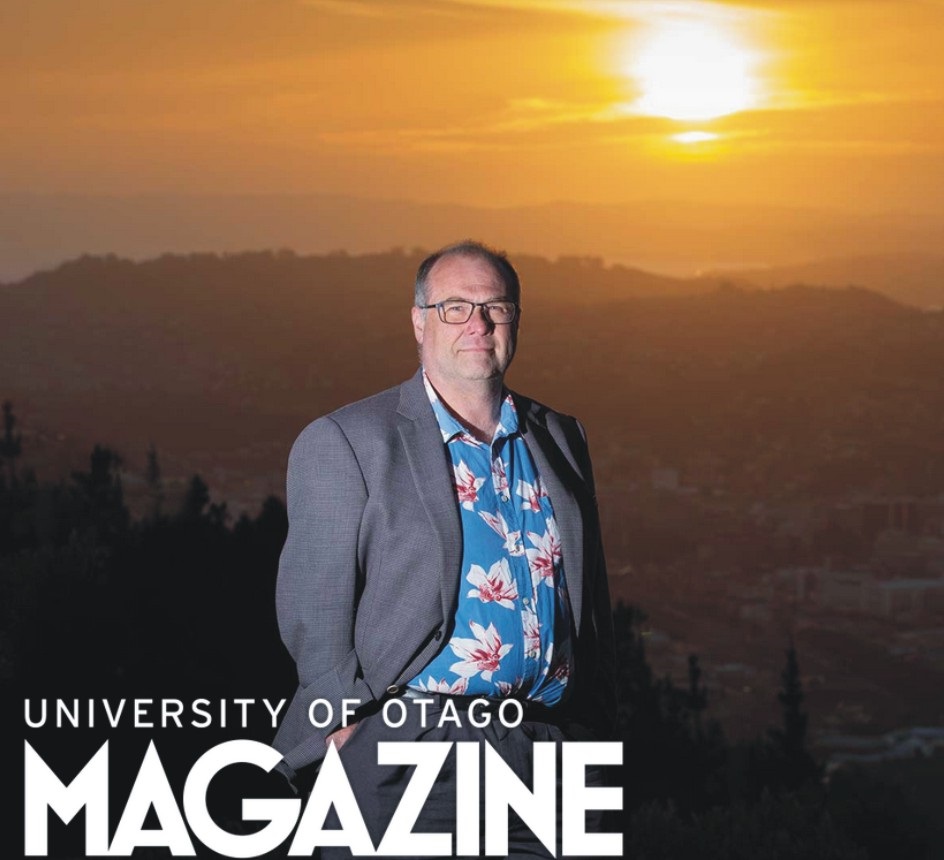
Space Physics Group Hosts MBIE Solar Tsunamis “Kick Off” Meeting
At the start of February we hosted the “kick off” meeting for the Solar Tsunamis: Space-Weather Prediction and Risk Mitigation for New Zealand’s Energy Infrastructure research programme, funded by the Ministry of Business, Innovation & Employment through the Endeavour Fund (1 October 2020-30 September 2025). This programme will investigates how solar explosions impact New Zealand energy networks, with our main focus on the electrical power network and natural gas pipelines. Our energy industry partners have identified the detailed questions that need to be answered. Our research will address these questions to allow mitigation of extreme storm space weather hazards.
The team met for the first time in Dunedin on 2 and 3 February 2021. All of the New Zealand-based partners were able to attend – but because of COVID boarder restrictions none of our international team members could come – although most were able to be present by zoom for parts of the days.
The picture below shows most of “in person” meeting participants. From left to right:
Ted Bertrand (GNS), Anna Tarr (Otago Univ Physics), Wiebke Heise (GNS), Tanja Petersen (GNS), Matt Parry (Otago Maths & Statistics), Ting Wang (Otago Maths & Statistics), Neville Watson (Canterbury University), Fernanda da Silva Tatley (Otago University Research Office), Mike Dalzell (Transpower), Pam Scowen (GNS), Craig Grant (Otago Museum), Craig Rodger (Otago Univ Physics), Jessa Barder (Otago Museum), Daniel MacManus (Otago Univ Physics), Malcolm Ingham (VUW), Aaron Hendry (Otago Univ Physics), James Brundell (Otago Univ Physics), Stewart Hardie (Canterbury University). Unfortunately, Andrew Lapthorn (Canterbury University) missed the photo.
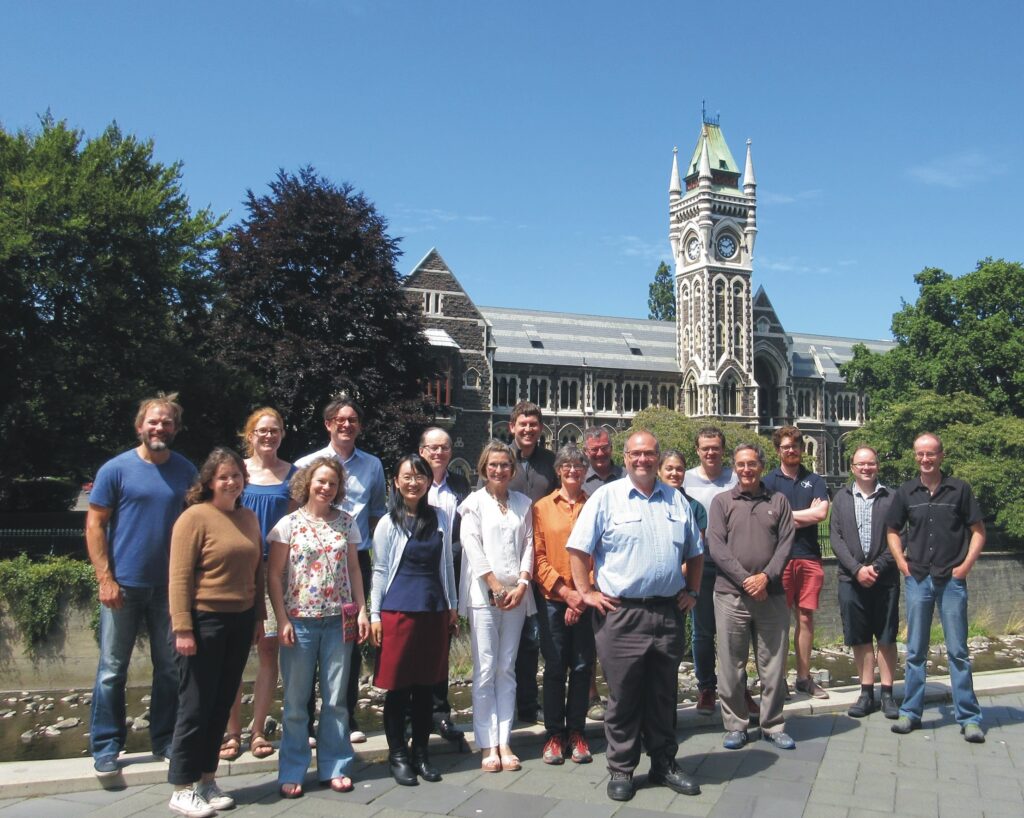
Space Physics Group Research Featured on Space Weather Cover
Today the group found out that a figure from one of our recently accepted papers was featured on the cover of the August edition of the AGU journal Space Weather. The paper (https://doi.org/10.1029/2020SW002494) titled Geomagnetically Induced Current Model Validation From New Zealand’s South Island, looks at GIC measurements at 23 transformers spanning New Zealand’s South Island to test our ability to validate modelling of Geomagnetically Induced Currents during gemagentic disturbances. Sensitivity analysis was carried out on the 2015 St Patrick’s day storm to identify the leading variable in GIC model predictions. This research was primary lead by Tim Divett and Daniel Mac Manus [13 November 2020].
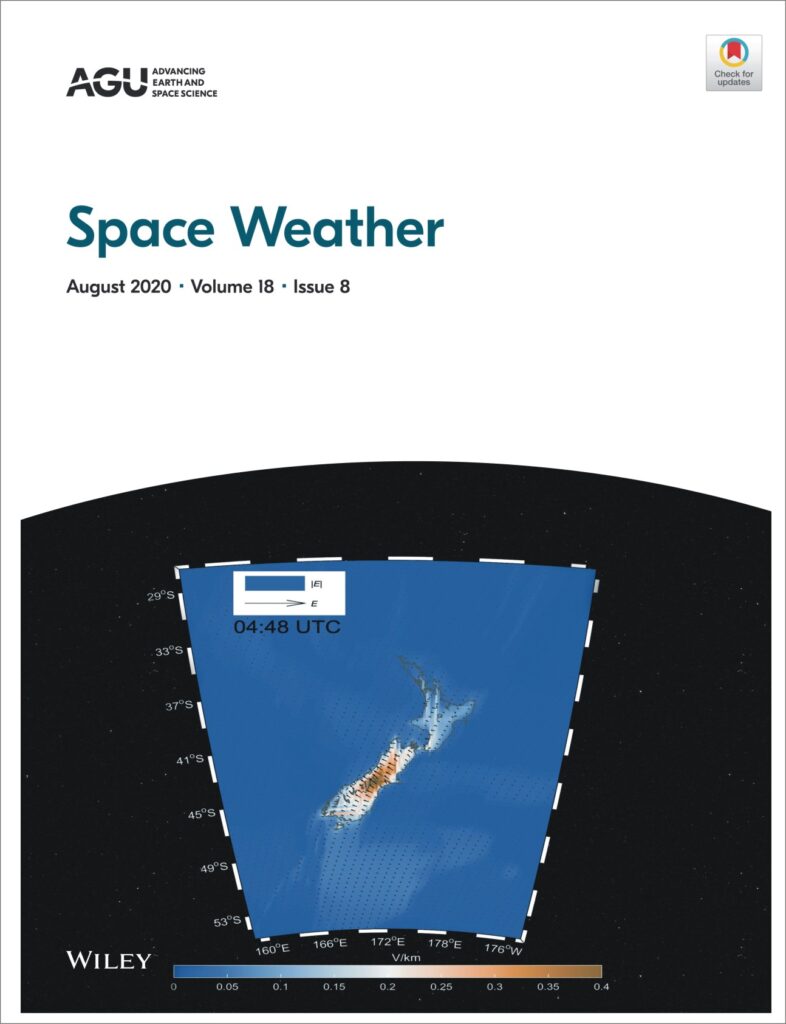
Marsden Success in Space Physics Group – well done Romain
Last week the group had the great news that Romain Meyrand has been awarded a 2020 Marsden Fast Start grant. Romain joined the group in October 2019 from France, and works primarily on the theory of plasma turbulence in the solar wind. His funded project is entitled “The role of electron turbulence in heating the solar corona” and aims to study the smallest scales of plasma turbulence, which are associated with the dynamics of electrons, in the regime of strong magnetic fields. The work ties in deeply to NASA’s recently launched Parker Solar Probe mission, which is currently making exquisitely detailed measurements of the near-sun solar wind and outer corona. The mission has the broad goal of understanding how the Sun’s corona is hundreds of times hotter than its photosphere just below, and will provide a wealth of new data that will help constrain the ideas that Romain develops as part of his project. With the Fast Start, Romain will be able to stay in New Zealand for three years longer than originally planned – we’re excited to keep him! [11 November 2020].
Space Physics Group wins huge MBIE Endeavour Fund funding
Yesterday New Zealand’s MBIE (Ministry of Business, Innovation & Employment) announced the results of the 2020 Endeavour Fund for Research Programmes. This government ministry made known they were to fund 17 research projects, providing a total of $187 million of funding over 4-5 years. The Endeavour Fund is New Zealand’s largest contestable research fund. Since the first Endeavour Round in 2016 (and not including the 2020 round), MBIE has invested in 265 projects with a total value of nearly $1 billion.
Professor Craig Rodger, Head of Otago’s Department of Physics, has received slightly more than NZ$15 million over 5 years for a project research entitled “Space-Weather prediction and risk mitigation for New Zealand’s energy infrastructure”. Our project team is lead by Otago Universities Physics Department, but also includes academics from the Mathematics and Statistics Department. In New Zealand, our partners are from GNS Science, Victoria University of Wellington, University of Canterbury, and Otago Museum. Internationally our project partners include the British Antarctic Survey, British Geological Survey, University of Texas at Arlington, ETH Zurich, Space Weather Canada, and NOAA’s SWPC. Our industry partners are Transpower New Zealand and First Gas Limited.
This is the highest every MBIE programme funding awarded to Otago University. A total of 128 MBIE programme applications were submitted to produce the 17 successful projects. Our project builds on our smaller MBIE funded project (2015-2018), which established that New Zealand’s energy networks are at risk from extreme geomagnetic disturbances – but also that New Zealand has an unusually dense high-quality set of measurements available to undertake Space Weather research. This earlier project forged our collaborations with industry, international researchers, plus crown research institute and university researchers – the network of people now funded to undertake the new, extremely large funded project.
While strongly New Zealand focused, the research will assist global understanding in space weather. The money will fund early career researchers and postgraduate students putting us in a world leading position. Yesterday was a very good day!
More information:
Otago’s press release
MBIE’s press release and their Full list of successful projects
Otago Universities Facebook post [12 September 2020].
Aaron’s paper an Editors’ Highlight
During the COVID-19 lockdown we worked from our homes, as best we could. At times this was tough, but it did come with good news; in early April Aaron Hendry’s most recent paper was published in the American Geophysical Union journal Geophysical Research Letters. But this week the news got better, as we heard the conclusions of this study have been selected as a Research Highlight by the editors of Geophysical Research Letters. The editors were impressed by the combination of space- and ground-based data. Aaron used measurements from two orbiting satellites (the NASA Van Allen Probe B and the Japanese Arase), plus the AARDDVARK network of ground-based subionospheric VLF receivers to successfully determine the longitudinal extent of the EMIC source region [9 August 2020].
Emily’s paper a top read
The paper Emily Gordon wrote to describe her MSc research has turned out to be very popular. While it was only recently published in in the journal Atmospheric Chemistry and Physics (impact factor 5.4) it has created so much interest that it is now the most downloaded paper from the journal over the last 12 months. Emiily’s paper has now been downloaded more than 5000 times!a The paper focuses on how Antarctic atmospheric chemistry changes are linked to space weather events (i.e. electrons hitting the Antarctic atmosphere from space). Congratulations to Emily and her supervisor Annika Seppälä. The paper has been featured by NASA, Antarctica New Zealand, and our Physics Department [5 August 2020].
Aaron Hendry starts working in the group (again)
In early 2018 Dr Aaron Hendry took up a postdoctoral fellowship position at the Department of Space Physics in the Institute of Atmospheric Physics in Prague. While this was very successful, he was keen to return to a role in New Zealand. The contract was due to end just as COVID-19 travel restrictions started to bite around the world, and Aaron managed to move his flights home and return to New Zealand just in time. On arrival he had to go into self-isolation which lasted through to the formal move to Level 4 lockdown which impacted across all of New Zealand. With the reopening of most of New Zealand in mid-May, Aaron started to think about looking for employment. He has now started a 6 month contract working with Craig in the Space Physics research group. It is good to have Aaron back with us, and we hope to be able to finish off some projects together – some of which date back to his time as a PhD student! [1 July 2020].
Emily and James feature in Antarctic Podcast
In November last year, Emily Gordon and James Brundell went to New Zealand’s Antarctic base Scott Base to look after our scientific equipment. Today Radio New Zealand released a podcast which features James and Emily. The podcast was made by Alison Ballance as part of the Our Changing World programme. Alison has been to Scott Base before, and interview Craig about our science during her 2010 trip South. This time Alison spoke to James and Emily inside the Arrival Heights New Zealand Laboratory. The podcast for the episode featuring James is called Voices from Antarctica 3: Flags to physics. The part where James is interviewed, and our work is featured, starts at ~10min 15 seconds and ends at about 20min. Alison and James talk about both our Antarctic VLF antenna, supporting space physics and lightning location research (AARDDVARK and WWLLN) [11 June 2020].
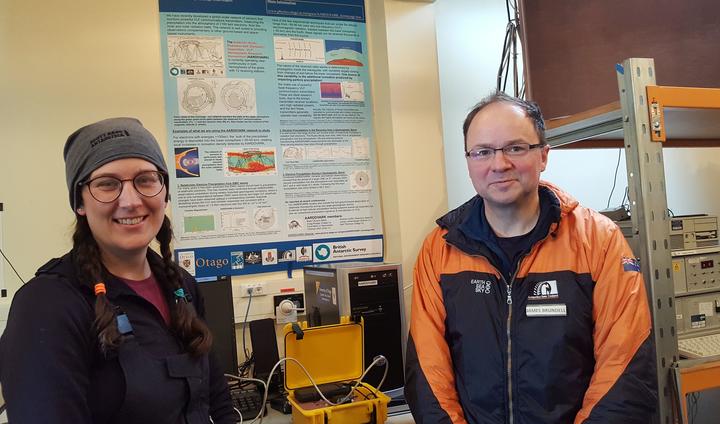
Emily and James standing in front of our experimental equipment at the Arrival Heights laboratory in Antarctica.
Working during the COVID-19 lockdown
On Thursday 14 May 2020, Craig returned to the Physics Department after a 7-week lockdown. The New Zealand government asked everyone to stay home and closed most workplaces by declaring Alert Level 4 would start from the end of Wednesday 25 March. The COVID-19 public health emergency in New Zealand had decreased significantly by mid-May, with the country shifting to Alert Level 2 on the Thursday morning. As Craig is the Head of Department, he led the planning for our “re-entry” into the Department for the laboratory based experimentalists (staff and postgraduate students) when we reached Level 3, and the entire department under Level 2 [17 May 2020].
The group worked from home during the lockdown – but we continued our weekly coffee sessions by Zoom and caught up with one another. And there were successes:
– During the lockdown MSc student Emily Gordon‘s paper EPP-NOx in Antarctic springtime stratospheric column: Evidence from observations and influence of the QBO was accepted for publication in Atmospheric Chemistry and Physics. While not a “journal highlight”, the paper has made a big splash, with over 2600 views and downloads by mid-May 2020! She and Annika are working on another paper, coming from Emily’s recently completed MSc.
– PhD student was offered two oral presentations for the COSPAR 2020 Scientific Assembly (originally in August 2020, now postponed to January 2021)
– Jono attended an online planet formation conference where he talked about his recent paper Physical models of streaming instabilities in protoplanetary disks
– Postdoctoral Fellow Romain Meyrand was invited into the second round of the New Zealand Marsden Fund with a Fast Start application. This is major success in its own right, as only ~15% of Fast Starts are funded, with most failing to reach the second round.
– And of course the groups Honours students worked hard on thier projects research while undertaking online lectures and assignments.
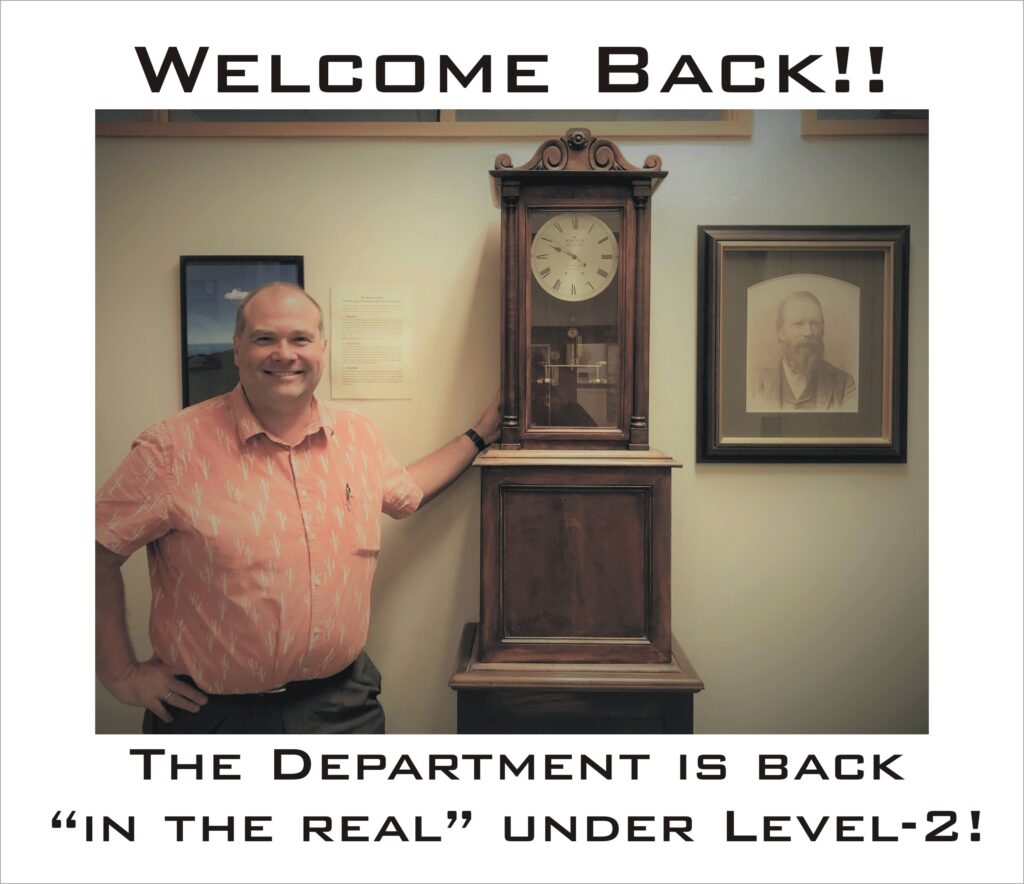
During the lockdown Craig mostly did admin to support the department.
Emily Gordon submits her MSc thesis for examination
Space Physics MSc student Emily Gordon has been working hard, but has finally reached the point where she could hand in her MSc thesis. Early this afternoon Emily and her supervisor Dr. Annika Seppälä went down to the Physics Department office to submit the thesis for examination. Emily is now going to enjoy a weeks downtime – before coming back to answer the reviewers comments on her paper currently being examined by Atmospheric Chemistry and Physics Discussions [28 February 2020].
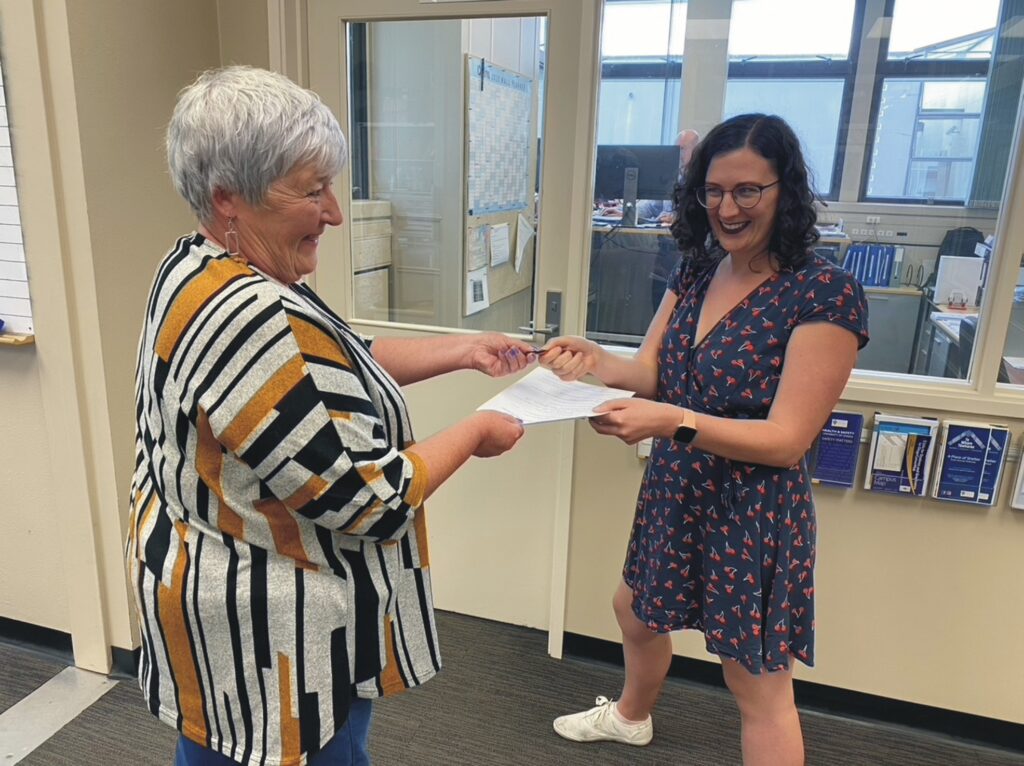
Emily hands the submission paper and USB stick with her thesis to Bev Reynolds (Physics Administrator).
Harriet’s paper an Editor’s Highlight
Great news for the start of the year. One of our recent papers have been declared an as a Research Highlight by the editors of the American Geophysical Union journal Space Weather. The research was based on the 400-level project work of Otago Honours student Harriet George; Harriet then advanced the work during a summer project in late 2018 before heading to Helsinki to start a PhD at the University of Helsinki. Harriet’s work shows that subionospheric VLF observations by networks like AARDDVARK can be used to provide rapid warning of large solar flares – both that the flare is happening, but also the size of the flare. This sort of observation is independent of satellite observations (allowing backup), but can also provide faster warnings that current satellite-based techniques. Large solar flares have been identified as a hazard for global aviation. The editors highlight was published in the American Geophysical Union online magazine, Eos. [28 January 2020]. Update: It was also featured in a special mention in Antarctica New Zealand’s 173rd Science Update on 27 February 2020.
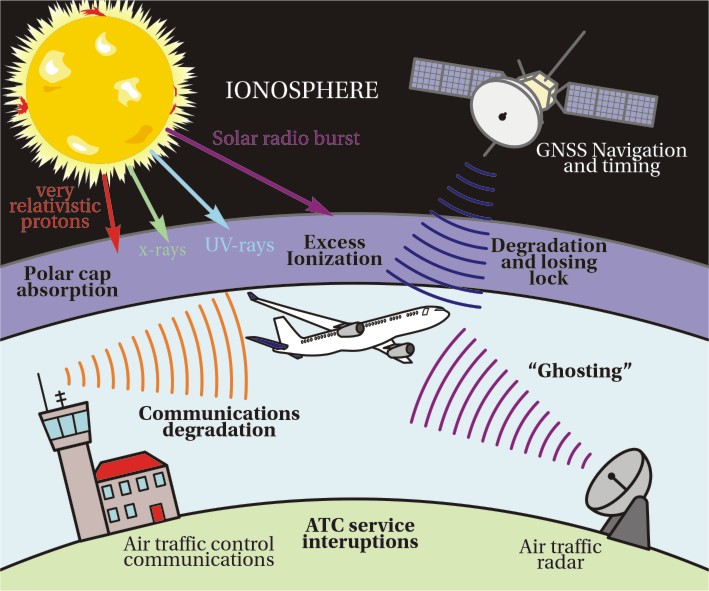
Illustration of the effects of solar flares on the ionosphere, and on aviation traffic control services. Image produced by Paul Muir (University of Otago, New Zealand)
Public Talk on the Aurora
Each year Otago University hosts hundreds of high school students for a week in Dunedin as part of the Hands on at Otago programme. In 2020 about 400 students came to the University, and their activity included an evening talk by Craig Rodger and Dr. Ian Griffin. Ian is the director of Otago Museum, an honorary fellow in the Otago Physics Department, and a keen speaker on astronomy (especially the aurora). On Monday 13 January 2020 Ian and Craig spoke about the scientific nature of the aurora, along with the many experiences they have had from chasing these awesome light shows [13 January 2020].
